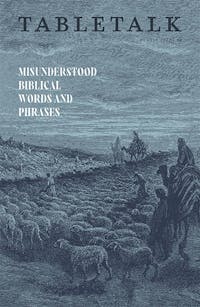
Request your free, three-month trial to Tabletalk magazine. You’ll receive the print issue monthly and gain immediate digital access to decades of archives. This trial is risk-free. No credit card required.
Try Tabletalk NowAlready receive Tabletalk magazine every month?
Verify your email address to gain unlimited access.
At first glance, there is nothing special about hyssop. Solomon spoke about the tall-growing cedars of Lebanon and the hyssop that grew out of a wall (1 Kings 4:33; Heb. 9:19). The cedars and hyssop were at opposite ends of the spectrum: from big and beautiful to small and stark. Hyssop is a small, bushy plant that generally grows in arid, rocky places such as walls. Its principal feature is the sponge-like shoots that collect moisture and transfer that moisture to other objects, particularly when the plant is shaken. Its simple ability to collect and disperse liquids is what made it suitable for its most significant function in the ceremonial rituals of the Old Testament, all of which were picture prophecies pointing to the sacrificial work of Christ.
New Testament references to hyssop underscore the truth that Christ is the fulfillment of the Old Testament ceremonies, making their continuance obsolete but not obliterating the significance of their message. Hebrews 9:19 specifically mentions the inadequacy of hyssop along with other elements of the Old Testament sacrifices in order to point to the superiority of the sacrifice of Christ, which actually accomplished what all the Old Testament types could only anticipate. Although not in the context of the Mosaic ceremonies, the reference to hyssop in John 19:29 ironically associates it with the supreme sacrifice of Jesus. The vinegar-soaked hyssop touching the parched lips of Jesus immediately preceded His dying declaration “It is finished” (John 19:30). With that declaration, any further ceremonial use of the hyssop became unnecessary. Nonetheless, looking at the hyssop in the Old Testament pictures highlights four realities that Christ’s sacrifice accomplished.
deliverance from bondage
The Passover marked the first use of hyssop. The Israelites were suffering a harsh bondage over which they had no control and from which they could not free themselves. In keeping with His covenant promise, God delivered them by a mighty display of His irresistible power. But central to the Passover was the sacrifice of the perfect lamb that was chosen to be a substitute for the firstborn. The lamb was slain as an execution of divine justice, and its blood was shed as a propitiation of divine wrath. Gallons and gallons of blood were shed that night, yet it was not the mere fact of blood that brought deliverance but the application of the blood. Here’s where the hyssop enters the picture. The Israelites were to dip hyssop in the blood and sprinkle it on the posts and upper part of the door (Ex. 12:22). Wherever the blood was applied, there was deliverance. This points directly to Christ, our Passover, who was sacrificed for us (1 Cor. 5:7). The hyssop specifically reminds us that it is not just the historic fact of the death of Christ that delivers from the power and bondage of sin but the application of His blood.
cleansing from sin
The next recorded use of hyssop is in connection with the cleansing from leprosy (Lev. 14). This leprosy was some sort of surface disorder that occurred on skin and in the walls of buildings; it was a vivid picture of the defiling nature of sin that separates man from God (Isa. 59:2). The leper had to be quarantined, separated from the covenant community. But leprosy had a cure, and sin has a remedy. Enter the hyssop and the ceremony of the two birds. One bird was slain with its blood dripping into water, and the living bird was released after it was dipped in bloody water. The priest then dipped hyssop into the mixture and used it to sprinkle the healed leper, declaring him to be clean and fit for worship at the tabernacle, where God met with His people (Lev. 14:11). This ceremony with the hyssop and two birds points directly to Jesus, whose blood cleanses from all sin (1 John 1:7).

reversal of the curse
Death is the ultimate consequence of sin, the climactic manifestation of the curse. The presence of death in the province of life is a constant reminder of that last great enemy. The next use of hyssop points to the solution to the problem. Numbers 19 records the procedure for dealing with the curse of death. A red heifer was to be killed and completely burned outside the camp. Its ashes were kept in reserve and mixed with water to be sprinkled with hyssop on whatever or whoever had been contaminated by contact with the dead. This ritualistic purification with hyssop pointed to the real and complete defeat of sin’s curse by Jesus (see Heb. 9).
restoration
David’s prayer of confession in Psalm 51:7 (literally, “De-sin me with hyssop”) figuratively sums up the theological significance of hyssop. His sin had robbed him of fellowship with God, and knowing that the only thing that could restore that fellowship was the hyssop, he expressed his faith in the cleansing of the blood of the sacrifice. So it is that we must appeal to the blood of Jesus in order to experience forgiveness of sins and the enjoyment of restored fellowship with Him (1 John 1:7, 9). There’s more to hyssop than meets the eye.
